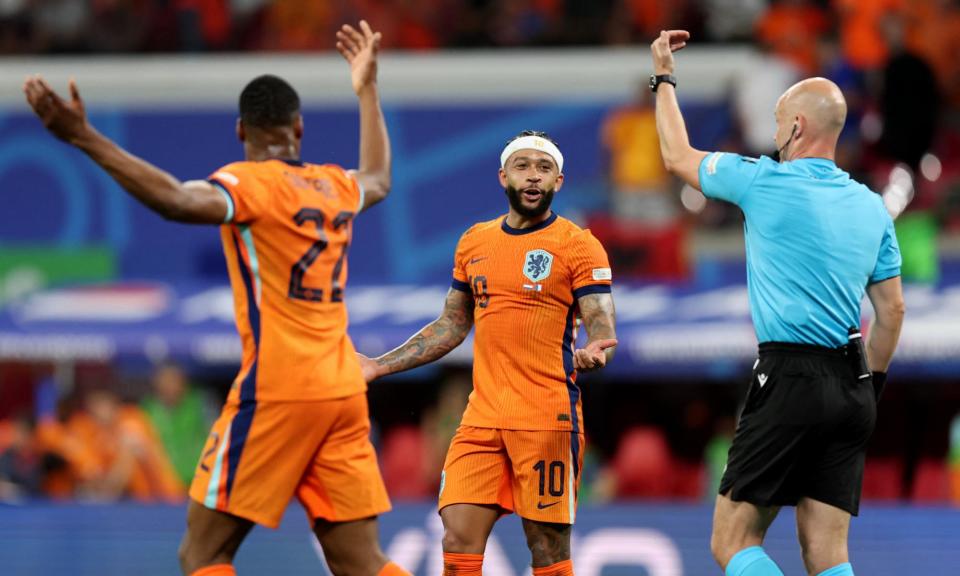Euro 2024 innovations helping referees but some things technology cannot fix

International football tournaments have often delivered innovation, be it in playing styles, tactical approaches or the Romania team all dyeing their hair blond at France 1998. In recent years we have been able to enjoy (if that’s the right word) another type of novelty: the technological developments that aim to help officials effectively apply the rules.
This summer in Germany has continued the trend. Euro 2024 has brought the introduction of what Uefa calls “connected ball technology”, a far less descriptive name for what cricket has long called the “snickometer”: a device that, through sound, picks up physical contact between objects. In cricket, there is a microphone in the stumps to capture the slightest snick between bat and pad. At the Euros, there is a microchip in the ball which performs the same function, and the devious little so-and-so recorded the slightest contact with Loïs Openda’s hand during Belgium’s defeat by Slovakia to make him the first player to be undone by “snicko”.
Related: Netherlands denied Simons winner by VAR as France rest Mbappé in draw
Openda’s undoing, with Belgium denied an equaliser, was perhaps the most notable “refereeing” intervention in the tournament so far, which is striking. The use of VAR at Euro 2024 has, by common consent, been seen to be doing well. Is this the future they promised us? Well, perhaps.
Alongside snicko, fans, players and coaches have also been getting used to semi-automated offside technology (SAOT). It has been deployed before, making its competitive debut at the Qatar World Cup, but it has been more visible in Germany and has had more scrutiny as domestic leagues prepare to introduce the technology (it’s coming to the Premier League this autumn).
What SAOT has inarguably achieved is to reduce the time it takes for officials to make a decision. Using the aforementioned chip and calibrating it with body positions caught by cameras around the ground, the SAOT software saves VAR officials from having to spend time drawing fiddly lines. Now all they have to do is look at what the software produces and check it isn’t glaringly wrong.
Uefa will be sharing data on the performance of VAR and SAOT at the end of the group stage, but a rough count suggests predictions that SAOT could take 30 seconds off the average 70 seconds it has previously taken for VARs to make offside calls seem about right. The sense of a functioning system has also been aided by improved information, both in the graphics that show the offending offside body parts and explanatory text published on the big screen in the ground.
Does that mean there have been no complaints? Of course not.
On Friday night the decision to disallow Xavi Simons’ goal against France, for offside against his Netherlands teammate Denzel Dumfries, provoked consternation and debate. Hungary’s manager, Marco Rossi, made accusations of double standards after a foul was not detected by VAR in the buildup to Germany’s opening goal in their Group A encounter (he insisted a foul was later given for a similar incident in the Germany box). The unfortunate Romelu Lukaku has had three goals overturned in two matches; one after the Openda snicko incident, another after an offside decision that involved the tip of his knee.
Related: De Bruyne and Tielemans sink Romania to get Belgium back on track
Each of these controversies remind us that there are some things in football that no amount of technology can fix. The vast majority of the laws require subjective interpretation by officials. On the Simons goal, the question was whether Dumfries was interfering with the ability of Mike Maignan to get to the ball, though not whether the goalkeeper would have missed it anyway. Openda definitely triggered the snickometer, but did he do it intentionally as is required by attacking players other than the goalscorer if a VAR is to intervene? Officials decided yes. Rossi thought that Ilkay Gündogan had shoved Willi Orban; Gündogan said: “If you gave that as a foul in the Premier League, I think everyone would have been laughing on the floor.”
The one issue that has drawn a fair amount of heat was the time required to reach a decision on Dumfries, where the question was not whether he was offside – a law that does not require subjective interpretation – but whether he was interfering with play. It took nearly three minutes from the referee, Anthony Taylor, blowing his whistle for offside to the VAR, Stuart Attwell, confirming the on-field decision.
And, yes, this is the same Attwell who provoked the ire of Nottingham Forest after “missing” three penalties against Luton in a Premier League match (a refereeing panel said he should definitely have awarded one). Attwell could not rely on SAOT to reach his decision. That may not explain it all away, however, meaning that even away from home English officials are likely to remain under focus.

 Yahoo Sport
Yahoo Sport 






































